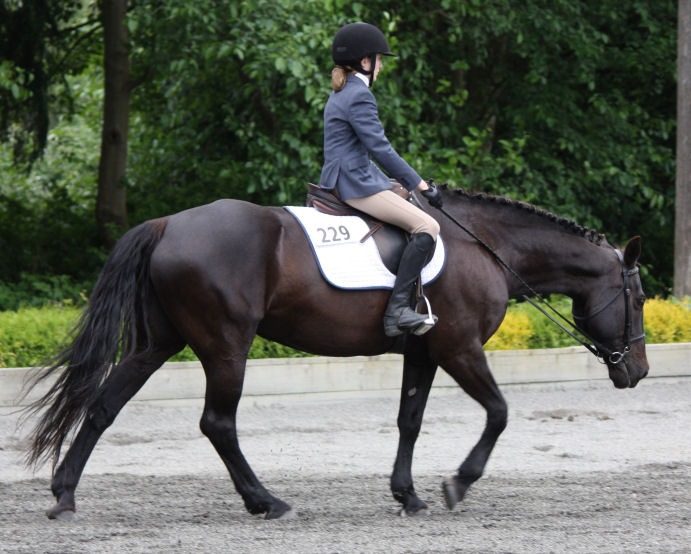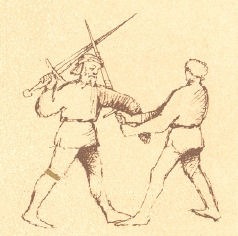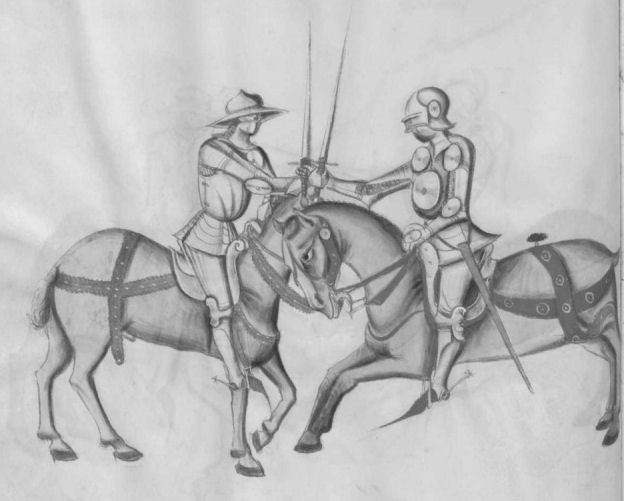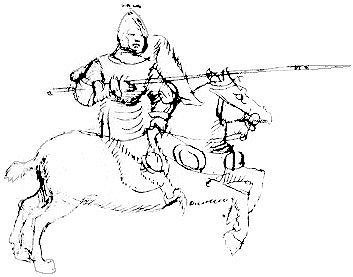Riding Level 3: Position
It's one of the first things we teach you when you start riding, and something your instructors will continue to adjust throughout your riding career. Your position in the saddle is far more than just a matter of aesthetics. Good position is the foundation of effective riding. At level three we are looking for:
2. Good position at walk, trot (sitting & rising) and canter.
First of all, take a moment to review position from Level 2. The basics still apply: a vertical line from ear through shoulder, hip & heel; another through knee and toe; and a straight line from bit to hand to elbow. This position puts your weight squarely over your centre of balance. As I'm fond of saying in beginner classes, if your horse were to disappear from beneath you in a puff of smoke you would land on your feet and not fall over (except perhaps from surprise).
To check your vertical alignment, stand in your stirrups and find your balance. Now lower yourself slowly to the saddle without moving your lower legs at all. You now will find your heels nicely lined up with your hips, and your centre of gravity directly over your stirrups. Your heels should be lower than your toes, and your chin up so you are looking squarely over the horse's ears. The well-worn saying 'heels down, head up' is worth repeating as a mantra until you no longer have to think about it.
The elbow-hand-bit connection is more difficult to check, and you will need an observer at first to tell you if your hands are at the correct height. However, you will soon get the feel of a correct hand position and it will become second nature. It is the most ergonomic position, giving you the maximum strength through your back and arms and suppleness through elbow and wrist. A rule of thumb (or rather, pinkie) is that if you extend your little finger straight down you should almost be able to touch your horse on the withers.

At the walk and canter your arm should be elastic: that is, your elbow bends and releases in time with the horse's gait. This is called a 'following' hand, and it allows you to maintain a constant soft connection with the horse's mouth, neither jerking the reins nor allowing them to go slack as the horse moves its head back and forth.
At the trot the horse's head does not move relative to the body, so your hands will stay very still. Your body must now move independently from your hands as you sit or post the trot. If you have trouble keeping your hands still at the trot, use the pinkie check described above, but actually lower your hands and press your little fingers to the horse's neck. Grasping a bit of mane with each pinky will also help stabilize your hand position while you learn.
Here is what we are looking for when we assess your position at Level 3:
1. Walk: Your body is upright and relaxed, maintaining a correct alignment (described above). Your hips move with the horse's gait, while your upper body is relatively still. Your hands are soft and follow the movement of the horse's head, while maintaining the straight line between bit and elbow. Your hands are just shy of vertical, with thumbs on top and wrists straight.
2. Rising Trot: Your lower legs maintain their position as your knee angle opens with each rising step. Your upper body moves slightly forward as you rise, following the horse's forward movement. As you sit you make soft contact with the saddle, in correct alignment. Your hands do not move relative to the horse's neck, and your elbows bend and release to adjust for the change in your body's position while posting. You should also, of course, be posting on the correct diagonal.
3. Sitting Trot: Your leg is relaxed but not loose, heels are down, and shoulders are squarely over your heels. Allow your hips to swing independently from the waist to absorb the motion of the trot. This will let you stick to the saddle without inordinate bouncing or, even worse, 'daylight' between you and the saddle. As with the rising trot, your hands should be still regardless of what your body is doing.
4. Canter: Your weight is firmly in your stirrups without bracing and your hips follow the wave-like motion of the canter. As with sitting trot, the motion is absorbed in your hips and waist, and your upper body remains relatively still and upright. Your elbows will bend and release to follow the movement of the horse's head, which is similar to, but larger than, the motion at the walk.
Be conscious of your position whenever you ride. Have a mental checklist: head, shoulders, elbows, hands, hips, knees and heels. Strive to make sure your position is perfectly balanced between left and right, and that you have about 60% of your weight in your stirrups, and 40% in your seat. Awareness of your position is the first step towards improving it, and improving your effectiveness as a rider. Don't worry if you fall out of good position -- we all do. The important thing is that your body remembers what good position is, and resumes it naturally.
Mounted Combat Skills Starts This Saturday
The four-week Mounted Combat Skills course will run on Saturdays from 3:00 - 4:30pm at Academie Duello throughout February. This is the perfect opportunity to work on the swordplay, spear, and grappling skills you need for your Green or Blue Spur. The first half hour of class is clinic time for supervised independent work, followed an hour of lesson time that will take you through the curriculum over the course of the month. This course won't be offered again until April or May, so make the most of the last dreary weeks of winter by polishing your skills in the warmth and comfort of the salle!
A whole slew of courses starts Sunday February 8th. Beginner Riding & Horsemanship and Riding & Horsemanship Level 2 run from 10am - noon for the next six weeks. Horsemanship Level 3 & 4 will be at noon, and Riding Level 3+ at 1:30pm. If you are planning to take any of these courses make sure to sign up in advance to be sure they run! Single classes are only available if the class is running anyway, and must be booked 24 hours in advance.
Mounted Combat Skills
Saturdays 7 – 28 Feb, 3:00 – 4:30pm
Academie Duello, 412 W Hastings St, Vancouver
$120 + gst
Beginner Riding & Horsemanship
Sundays 8 Feb – 15 March, 10am – noon
Red Colt Equestrian Farm Co-op, 12320 No 2 Road, Richmond
$300 + gst
Level 2 Riding & Horsemanship
Sundays 8 Feb – 15 March, 10am – noon
Red Colt Equestrian Farm Co-op, 12320 No 2 Road, Richmond
$300 + gst
Horsemanship Level 3 or 4
Sundays 8 Feb – 15 March, noon – 1pm
Red Colt Equestrian Farm Co-op, 12320 No 2 Road, Richmond
$130 + gst
Riding Level 3+
Sundays 8 Feb – 15 March, 1:30 – 2:30pm
Red Colt Equestrian Farm Co-op, 12320 No 2 Road, Richmond
$200 + gst
Cavaliere Assessments
Sunday 1 March, 2:30 - 5:30pm
Red Colt Equestrian Farm Co-op, 12320 No 2 Road, Richmond
$50 for partial assessment (Horsemanship, Riding OR Mounted Combat)
Mounted Combat)
$80 for full assessment (2 or 3 of the above elements)
Mounted Combat
Sundays 8 & 15 March, 12 & 19 April, 2:30 - 4:00pm
Red Colt Equestrian Farm Co-op, 12320 No 2 Road, Richmond
$200 + gst
Intro to Mounted Combat
Sunday 5 April, 10am – 1pm
Red Colt Equestrian Farm Co-op, 12320 No 2 Road, Richmond
$149 + gst
Mounted Combat Playday
Sunday 5 April, 1pm - 4pm
Red Colt Equestrian Farm Co-op, 12320 No 2 Road, Richmond
$15 + $15 for use of school horse
Congratulations
We had eight riders taking part in our first Playday of 2015. Congrats to Stephanie Laversin who came away with the high score, and who wins free entry to the next one! In second place was Kirsten Call, and with a close third, the team of Isabel & Eleanor Landels.
Bending: (1) Stephanie Laversin; (2) Kirsten Call; (3) Noelle Phillips; (4) Karissa King.
Rings: (1) Isabel & Eleanor; (2) Stephanie Laversin; (3) Kirsten Call; (4) Cassandra Tattrie.
Stick Pegging: (1) Isabel & Eleanor; (2) Chris Richardson; (3) Stephanie Laversin; (4) Kirsten Call.
Ball & Racquet: (1) Stephanie Laversin; (2) Kirsten Call; (3) Noelle Phillips; (4) Karissa King.
We did some practice shooting but did not run a Horseback Archery competition or Mounted Sparring this time around. We hope, however, to include those activities in the April Playday. Till then, keep practising!
